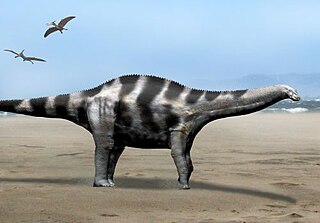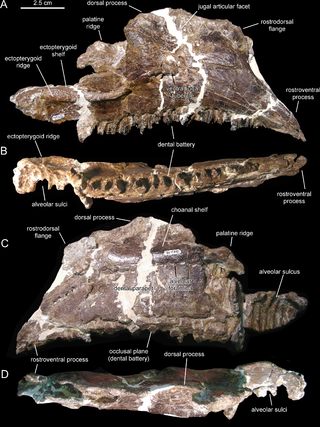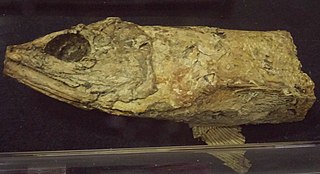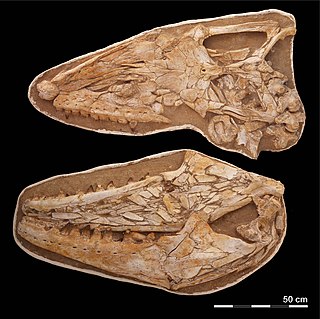
Pyroraptor is an extinct genus of paravian dinosaur, probably a dromaeosaurid or unenlagiid, from the Late Cretaceous Ibero-Armorican island, of what is now southern France and northern Spain. It lived during the late Campanian and early Maastrichtian stages, approximately 83.5 to 70.6 million years ago. It is known from a single partial specimen that was found in Provence in 1992, after a forest fire. The animal was named Pyroraptor olympius by Allain and Taquet in 2000.

The Halisaurinae are a subfamily of mosasaurs, a group of Late Cretaceous marine lizards. They were small to medium-sized, ranging from just under 3 meters in Eonatator sternbergi to as much as 8 or 9 meters in Pluridens serpentis. They tended to have relatively slender jaws and small, numerous teeth, suggesting a diet of small fish and other prey. Although the skeleton is primitive compared to other Mosasauridae in many respects, halisaurines had the distinctive hypocercal tail of other mosasaurids suggesting good swimming ability, and they persisted alongside other mosasaurs until the end of the Cretaceous. The earliest known remains of halisaurines occur in rocks of Santonian age and the subfamily persists until the latest Maastrichtian. Halisaurines are known from North and South America, Europe, Asia and Africa, indicating a more or less global distribution in the Late Cretaceous. Four genera are currently recognized: Eonatator, Halisaurus, Phosphorosaurus and Pluridens.

Lirainosaurus is a genus of titanosaur sauropod which lived in what is now Spain. The type species, Lirainosaurus astibiae, was described by Sanz, Powell, Le Loeuff, Martinez, and Pereda-Suberbiola in 1999. It was a relatively small sauropod, measuring 4 metres (13 ft) long, possibly up to 6 metres (20 ft) long for the largest individuals, and weighed about 2–4 metric tons.

Pterodactylidae is a controversial group of pterosaurs. During the 2000s and 2010s, several competing definitions for the various Jurassic pterodactyloid groups were proposed. Pereda-Suberbiola et al. (2012) used Fabien Knoll's (2000) definition of the name Pterodactylidae. Knoll had defined Pterodactylidae as a clade containing "Pterodactylus antiquus, Ctenochasma elegans, their most recent common ancestor and all its descendants". Using this definition with the analysis conducted by Pereda-Suberbiola et al. (2012) meant that Ctenochasmatoidea was nested inside Pterodactylidae.

Phosphatodraco is a genus of azhdarchid pterosaur that lived during the Late Cretaceous of what is now Morocco. In 2000, a pterosaur specimen consisting of five cervical (neck) vertebrae was discovered in the Ouled Abdoun Phosphatic Basin. The specimen was made the holotype of the new genus and species Phosphatodraco mauritanicus in 2003; the genus name means "dragon from the phosphates", and the specific name refers to the region of Mauretania. Phosphatodraco was the first Late Cretaceous pterosaur known from North Africa, and the second pterosaur genus described from Morocco. It is one of the only known azhdarchids preserving a relatively complete neck, and was one of the last known pterosaurs. Additional cervical vertebrae have since been assigned to the genus, and it has been suggested that fossils of the pterosaur Tethydraco represent wing elements of Phosphatodraco.
Ocepesuchus is an extinct genus of gavialoid crocodilian, related to modern gharials. Ocepesuchus is the oldest known crocodilian of Africa, and is known only from a single species, O. eoafricanus. It lived in Morocco during the late Maastrichtian age of the Late Cretaceous.
Eromangasaurus is an extinct genus of elasmosaurid known from northern Queensland of Australia.
The Marnes d’Auzas Formation is a geological Formation in southwestern France whose strata date back to the Late Maastrichtian. It is about 100 metres thick and consists primarily of marls with some interbeds of sandstones. It corresponds to sediments whose depositional environment evolved from the paralic domain at the base of the formation, towards a more continental domain in its upper part. The Marnes d’Auzas Formation was deposited in the west coast of the former Ibero-Armorican Island, which included much of France and Spain.

Zarafasaura is an extinct genus of elasmosaurid known from the Oulad Abdoun Basin of Morocco. As a relatively small elasmosaur, it would have measured around 3–4 metres (9.8–13.1 ft) long and weighed about 100 kilograms (220 lb).

Blasisaurus is a genus of lambeosaurine hadrosaurid dinosaur from the Late Cretaceous. It is known from a partial skull and skeleton found in late Maastrichtian-age rocks of Spain. The type species is Blasisaurus canudoi, described in 2010 by Penélope Cruzado-Caballero, Xabier Pereda-Suberbiola and José Ignacio Ruiz-Omeñaca, a group of researchers from Spain.

Demandasaurus is a genus of rebbachisaurid sauropod dinosaur from early Cretaceous deposits of Spain. Demandasaurus is known from an incomplete but associated skeleton that includes cranial and postcranial remains. It was collected from the Castrillo de la Reina Formation in Burgos Province of Spain. It was first named by Fidel Torcida Fernández-Baldor, José Ignacio Canudo, Pedro Huerta, Diego Montero, Xabier Pereda Suberbiola and Leonardo Salgado in 2011 and the type species is Demandasaurus darwini.

Canardia is an extinct genus of lambeosaurine dinosaur known from the Late Cretaceous Marnes d'Auzas Formation of Haute-Garonne department, in Occitanie region, southwestern France. The type species Canardia garonnensis was first described and named by Albert Prieto-Márquez, Fabio M. Dalla Vecchia, Rodrigo Gaete and Àngel Galobart in 2013. It is only known from juvenile specimens. The name of the genus comes from “canard”, the French word for “duck”, an allusion to the fact that this animal belongs to the hadrosaurids which are also known as duck-billed dinosaurs. The specific epithet garonnensis refers to the Haute-Garonne department where this dinosaur has been found. Although universally recognized as a lambeosaurine, its precise position within them is debated. Some authors consider it as a close relative of the genus Aralosaurus from Central Asia with which it would form the tribe Aralosaurini, while others include it in a more derived clade, the Arenysaurini in which all lambeosaurines from Europe and North Africa are placed. Canardia was one of the last non-avian dinosaurs and lived between 67,5 and 66 my on the former Ibero-Armorican Island, which included much of France and Spain.

The Oulad Abdoun Basin is a phosphate sedimentary basin located in Morocco, near the city of Khouribga. It is the largest in Morocco, comprising 44% of Morocco's phosphate reserves, and at least 26.8 billion tons of phosphate. It is also known as an important site for vertebrate fossils, with deposits ranging from the Late Cretaceous (Cenomanian-Turonian) to the Eocene epoch (Ypresian), a period of about 25 million years.
Laño is a hamlet and concejo in Condado de Treviño within the Treviño enclave; which is administratively part of the Spanish province of Burgos, but which is completely surrounded by the territory of the Basque country province of Álava. It is best known for the fossils of extinct vertebrates dating from around 70 million years before present which have been found there.

Goulmimichthys is an extinct genus of ray-finned fishes in the family Pachyrhizodontidae. The genus, first described by Cavin in 1995, is known from various Turonian age formations. The type species G. arambourgi from the Akrabou Formation in the El Rachidia Province of Morocco, and other fossils described are G. gasparini of the La Frontera Formation, Colombia, and G. roberti from the Agua Nueva Formation of Mexico.
The Castrillo de la Reina Formation is a geological formation in Spain. It is late Barremian to early Aptian in age. It interpreted as a fluvial deposit. It primarily consists of red clay, with ribbon shaped sandstone channel fills. The rebbachisaurid dinosaur Demandasaurus occurs in the formation, alongside somphospondylan Europatitan as well as indeterminate small ornithopods, iguanodonts and spinosaurids, the earliest known stem-rhabdodontid (indeterminate) and the lizard Arcanosaurus.

The Jizera Formation is a geologic unit of Late Cretaceous (Turonian) age, located in the Czech Republic. It is a unit of the Bohemian Cretaceous Basin. It consists of fluvial to shallow marine sediments and pterosaur fossils are among the remains found in the Jizera Formation. The type locality of the Jizera Formation is a quarry in Zářecká Lhota.

Thalassotitan is an extinct genus of large mosasaurs that lived during the late Maastrichtian of the Cretaceous period in what is now Morocco, around 66 million years ago. The only known species is T. atrox, described in 2022 from fossils discovered in the Ouled Abdoun Basin, where many other mosasaurs have been found. It was assigned to the tribe Prognathodontini alongside other mosasaurs like Prognathodon and Gnathomortis. The prognathodontines are separated from other mosasaurs based on their massive jaws and robust teeth.












